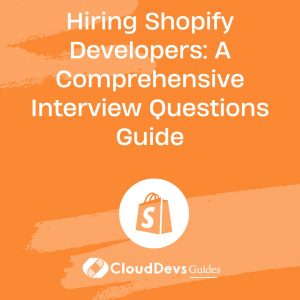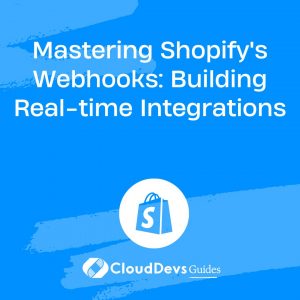Hiring Shopify Developers: A Comprehensive Interview Questions Guide
In the realm of e-commerce, Shopify stands out as a dominant platform and proficient Shopify developers play a pivotal role in creating exceptional online shopping experiences. To navigate the process of hiring Shopify developers effectively, this guide equips you with essential interview questions and strategies to identify top-tier candidates with the technical prowess, problem-solving acumen, and Shopify expertise your team needs.
Table of Contents
1. How to Hire Shopify Developers
Embark on the journey of hiring Shopify developers with these strategic steps:
- Job Requirements: Define specific job prerequisites outlining the desired skills and experience for your Shopify development role.
- Search Channels: Utilize job boards, online platforms, and e-commerce communities to identify potential Shopify developer candidates.
- Screening: Evaluate candidates based on their Shopify proficiency, previous e-commerce experience, and supplementary skills.
- Technical Assessment: Develop a comprehensive technical assessment to gauge candidates’ coding skills, app development expertise, and problem-solving abilities.
2. Key Skills to Look for in Shopify Developers
When evaluating Shopify developers, prioritize these core skills:
- Shopify Expertise: Profound knowledge of the Shopify platform, including theme customization, app integration, and store setup.
- E-commerce Experience: Familiarity with e-commerce best practices, user experience optimization, and online payment gateways.
- Liquid Templating Language: Proficiency in the Liquid templating language to customize Shopify themes and build dynamic store elements.
- App Development: Experience in developing custom Shopify apps to extend store functionality and enhance the customer experience.
- Front-End Technologies: Knowledge of HTML, CSS, and JavaScript for crafting visually appealing and responsive e-commerce interfaces.
- Version Control: Proficiency in using version control systems like Git to collaborate effectively with team members on codebases.
3. Shopify Developer Hiring Process
Overview Here’s a high-level overview of the Shopify developer hiring process:
3.1 Define Job Requirements and Skillsets
Establish a solid foundation by outlining clear job requirements, and detailing the skills and experience you’re seeking in Shopify developer candidates.
3.2 Craft Compelling Job Descriptions
Create engaging job descriptions that effectively convey the responsibilities and opportunities associated with the Shopify development role.
3.3 Develop Shopify Developer Interview Questions
Design a comprehensive set of interview questions encompassing Shopify intricacies, problem-solving aptitude, and relevant e-commerce technologies.
4. Sample Shopify Developer Interview Questions and Answers
Explore these sample questions and answers to assess candidates’ Shopify skills:
Q1. Describe the process of creating a custom Shopify theme. What components and tools are involved?
A: Creating a custom Shopify theme involves designing the layout using HTML and CSS, customizing functionality with JavaScript, and utilizing the Liquid templating language for dynamic content. Shopify’s Theme Kit or online code editor can be used to develop and deploy the theme.
Q2. Explain the concept of a Shopify app and its significance for e-commerce stores.
A: A Shopify app is a software extension that adds new features or modifies existing functionality of a Shopify store. These apps enhance the store’s capabilities, offer personalized experiences, and cater to specific business needs.
Q3. Implement a Liquid filter in Shopify that capitalizes the first letter of each word in a sentence.
{{ "hello world" | capitalize }}
Q4. What are Webhooks in Shopify? How can they be used to automate tasks in an online store?
A: Webhooks in Shopify are HTTP callbacks triggered by specific events within a store, such as order creation or product updates. Developers can use webhooks to automate tasks like sending notifications, updating external systems, or syncing data.
Q5. Describe the process of adding a new section to a Shopify theme using Liquid templates.
A: To add a new section to a Shopify theme, create a new .liquid file in the sections directory of the theme. Define the content and structure using HTML and Liquid code. Then, include the new section in a template using the {% section %} tag.
Q6. What is the purpose of the “metafield” concept in Shopify? How can it be utilized to store additional information?
A: Metafields in Shopify allow you to store extra information associated with products, customers, orders, and other entities. They can be used to add custom attributes, tags, or additional data that isn’t provided by default.
Q7. Implement a Shopify script using the Shopify Script Editor to offer a discount on products in a specific collection.
Input.cart.line_items.each do |item|
if item.variant.product.collections.any? { |col| col.handle == 'special-collection' }
item.change_line_price(item.line_price * 0.9, message: "10% off special collection")
end
end
Q8. Explain how Shopify themes can be optimized for mobile responsiveness and performance.
A: To optimize Shopify themes for mobile, use responsive design principles and CSS media queries to adapt layouts to different screen sizes. Additionally, optimize image sizes, minimize HTTP requests, and utilize caching mechanisms for improved performance.
Q9. What is GraphQL, and how is it utilized in Shopify app development?
A: GraphQL is a query language for APIs that enables clients to request specific data from the server, reducing over-fetching or under-fetching of information. In Shopify app development, GraphQL can be used to retrieve product details, customer information, and more efficiently.
Q10. How can you extend the functionality of a Shopify store using private and custom Shopify apps?
A: Private apps are custom integrations created within a specific Shopify store to perform tasks like automating data syncing or enhancing workflow. Custom apps, on the other hand, are developed externally and can be published on the Shopify App Store for broader usage across multiple stores.
5. Hiring Shopify Developers through CloudDevs
Step 1: Connect with CloudDevs: Initiate a conversation with a CloudDevs consultant to discuss the unique requirements of your Shopify development project, preferred skillsets, and desired experience levels.
Step 2: Discover the Ideal Match: Within a brief period, CloudDevs presents you with meticulously curated Shopify developers from their network of pre-vetted professionals. Review their profiles and select the candidate who aligns harmoniously with your project’s vision.
Step 3: Embark on a Trial Engagement: Engage in productive discussions with your chosen developer to ensure a seamless integration into your team. Once confident, formalize the collaboration and embark on a week-long free trial period.
By leveraging the expertise of CloudDevs, you can seamlessly identify and hire top-tier Shopify developers, ensuring your team possesses the necessary skills to craft remarkable e-commerce solutions.
6. Conclusion
Armed with these comprehensive interview questions and insights, you’re now well-equipped to assess Shopify developers comprehensively. Whether you’re crafting captivating online stores or building custom e-commerce apps, securing the right Shopify developers through CloudDevs is pivotal to achieving success in your projects.
Table of Contents








